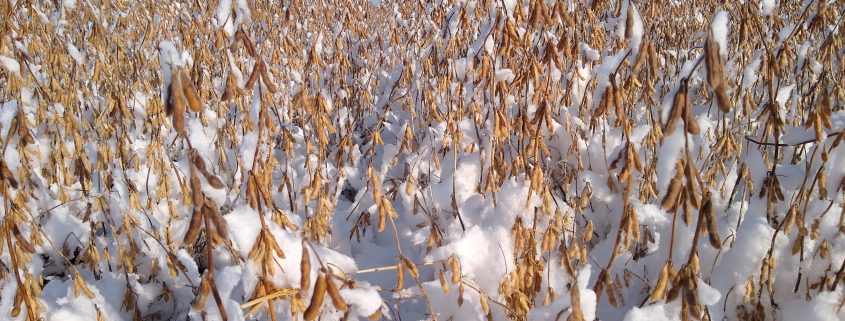Dealing with Wet Frozen Soybeans
Like many farmers the UW BeanTeam still has soybean sitting in the field. Both locations (FDL and East Troy) have not been fit to run since maturity and FDL had 7 inches of snow piled on top of standing water yesterday. Anyway…. once fields freeze and we can get back after the crop, here are a few things to consider. Check back as this information will likely be updated as I glean more information and receive audience feedback. This information is provided in greater detail in the below two excellent resources.
- Call and mail (i.e. paper trail) your crop insurance agent to let them know you may not be able to get the crop out before the deadline.
- Take what you can get this fall. Soybean does not “store” well in the field over the winter. Shatter and seed quality degradation may lead to an unmarketable crop if taken in the spring.
- Set the combine and check it often if you are running snow through the housing. The cold temperatures may be to our advantage as the snow should move easier.
- Header shatter will be an issue. Make sure you set the combine to manage flow. Remember for every 4 seeds per square foot on the ground that equates to roughly a bushel in yield loss.
- Double check your combine moisture with another device to verify correct moisture as this cold weather will wreak havoc with sensors. We pulled beans today and they were 16.4%.
- Call ahead and around. Verify what the elevators will take in terms of moisture content. Furthermore some elevators are assigning a wet bin to assist farmers in harvest.
- Do not harvest and store wet beans on farm. I have heard some coffee shop talk about cutting and “freeze blasting the soybean seed”. This is a bad idea.
- Don’t use too much heat. It appears that 100F is about the right temperature to minimize splits.
Drying and storing wet soybeans
Harvesting and storing soybeans
Updates from Brian Luck regarding combine settings:
Harvesting soybeans later than intended can present many challenges for minimizing harvest losses. These challenges are amplified when snow is on the ground and impacting harvest. Minimization of losses starts at the header. Checking that the sickle bar knives are sharp and the guards are adjusted properly will ensure the stems are being cut rather than broken or leaned over by the header. Generally, reel speed should be slightly faster than grounds speed to make certain the plants are being collected by the header. Another good practice for harvesting soybeans in wet and snow covered conditions is to reduce the combine ground speed while harvesting. This will give the machine extra time to cut the plants and ensure that they are transported to the throat of the machine with minimal damage or losses.
Concave clearances, rotor speeds, fan speeds, and sieve settings all depend on the condition of the crop at harvest. If the beans are generally dry but the stems, pods, and remaining leaves have increased moisture contents more aggressive threshing may be required to clean the plant material from the crop. More aggressive threshing can also lead to damage and reduced crop quality. Incremental adjustments of concave clearances (increase for wet conditions) then threshing rotor speed (increase for wet conditions) will help to find the optimal settings. Also, ensure that you have a uniform feed rate into the machine maintaining a consistent load on the threshing rotor to ensure optimal performance. Finally, increased fan speed can help pneumatically separate the soybeans from the plant material, however this can also lead to greater losses through the sieves if set too high.
Small adjustments to these combine settings can have a big impact on the performance of the machine. Check for losses behind the combine often to make certain that your harvest is as efficient as it can be in adverse conditions. Try to identify where losses are happening when operating the machine. If you can see beans leaving the header focus on minimizing that loss before making any other adjustments. Incorrect settings at multiple stages in the combine can significantly increase losses and will be difficult to identify.
References:
https://cropwatch.unl.edu/2017/tips-harvesting-soybeans-13-15-moisture
https://www.canr.msu.edu/news/recommendations_for_a_late_soybean_harvest
https://agfax.com/2019/10/09/ohio-soybeans-is-a-late-harvest-in-your-future/




